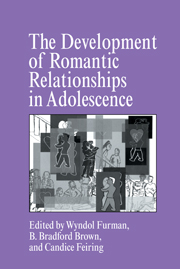Book contents
- Frontmatter
- Contents
- Contributors
- Foreword
- Acknowledgments
- 1 Missing the Love Boat: Why Researchers Have Shied Away from Adolescent Romance
- Part I Processes in Romantic Relationships
- Part II Individual Differences in Romantic Relationships
- 6 Capacity for Intimate Relationships: A Developmental Construction
- 7 Rejection Sensitivity and Adolescent Romantic Relationships
- 8 Sex, Dating, Passionate Friendships, and Romance: Intimate Peer Relations Among Lesbian, Gay, and Bisexual Adolescents
- 9 Gender Identity and the Development of Romantic Relationships in Adolescence
- Part III The Social Context of Romantic Relationships
- Part IV Conclusion
- Author Index
- Subject Index
8 - Sex, Dating, Passionate Friendships, and Romance: Intimate Peer Relations Among Lesbian, Gay, and Bisexual Adolescents
Published online by Cambridge University Press: 05 October 2014
- Frontmatter
- Contents
- Contributors
- Foreword
- Acknowledgments
- 1 Missing the Love Boat: Why Researchers Have Shied Away from Adolescent Romance
- Part I Processes in Romantic Relationships
- Part II Individual Differences in Romantic Relationships
- 6 Capacity for Intimate Relationships: A Developmental Construction
- 7 Rejection Sensitivity and Adolescent Romantic Relationships
- 8 Sex, Dating, Passionate Friendships, and Romance: Intimate Peer Relations Among Lesbian, Gay, and Bisexual Adolescents
- 9 Gender Identity and the Development of Romantic Relationships in Adolescence
- Part III The Social Context of Romantic Relationships
- Part IV Conclusion
- Author Index
- Subject Index
Summary
Although the raw number of adolescent romantic and sexual involvements is well documented, the actual experience and meaning of these relationships for adolescents receives little attention. As a result, these relationships are frequently classed together on the basis of surface similarities, despite important structural and functional differences. Attention to these differences, however, reveals how young men and women craft adaptive constellations of peer relationships to meet changing needs for intimacy and social support during the multiple transitions of adolescence. In this chapter we put forth a typology of intimate peer relationships based on the motives prompting adolescents to pursue them, their specific characteristics, and the functions they serve. We specify four varieties of adolescent relationships – sexual relationships, dating relationships, passionate friendships, and romantic relationships – representing prototypical combinations of some of the most salient motives, characteristics, and functions.
Three qualifications are in order. First, our use of this typology is primarily heuristic. We do not suggest that all adolescent intimate relationships can or should be shoehorned into one of these categories or that such a task has any intrinsic value. Rather, we elaborate these relationship categories to demonstrate how an analysis of the motives, characteristics, and functions underlying adolescent intimate relationships elucidates their developmental significance better than an analysis of surface features alone.
- Type
- Chapter
- Information
- The Development of Romantic Relationships in Adolescence , pp. 175 - 210Publisher: Cambridge University PressPrint publication year: 1999
- 68
- Cited by



